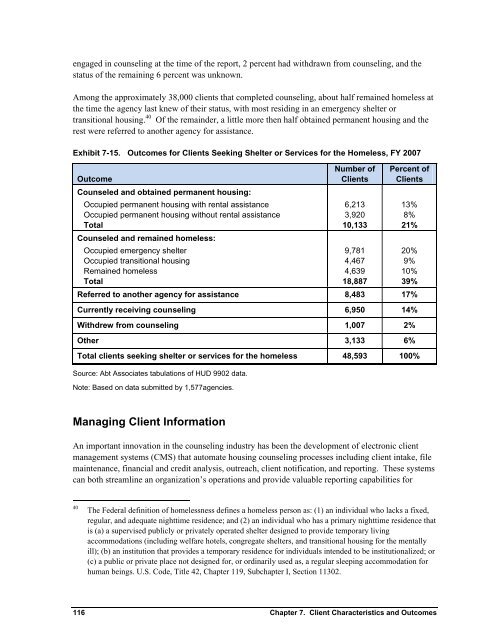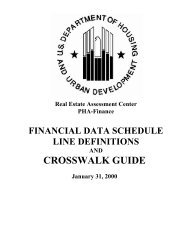Housing Counseling Process Evaluation and Design of ... - HUD User
Housing Counseling Process Evaluation and Design of ... - HUD User
Housing Counseling Process Evaluation and Design of ... - HUD User
You also want an ePaper? Increase the reach of your titles
YUMPU automatically turns print PDFs into web optimized ePapers that Google loves.
engaged in counseling at the time <strong>of</strong> the report, 2 percent had withdrawn from counseling, <strong>and</strong> the<br />
status <strong>of</strong> the remaining 6 percent was unknown.<br />
Among the approximately 38,000 clients that completed counseling, about half remained homeless at<br />
the time the agency last knew <strong>of</strong> their status, with most residing in an emergency shelter or<br />
transitional housing. 40 Of the remainder, a little more then half obtained permanent housing <strong>and</strong> the<br />
rest were referred to another agency for assistance.<br />
Exhibit 7-15. Outcomes for Clients Seeking Shelter or Services for the Homeless, FY 2007<br />
Outcome<br />
Counseled <strong>and</strong> obtained permanent housing:<br />
Occupied permanent housing with rental assistance<br />
Occupied permanent housing without rental assistance<br />
Total<br />
Counseled <strong>and</strong> remained homeless:<br />
Occupied emergency shelter<br />
Occupied transitional housing<br />
Remained homeless<br />
Total<br />
Referred to another agency for assistance<br />
Currently receiving counseling<br />
Withdrew from counseling<br />
Other<br />
Total clients seeking shelter or services for the homeless<br />
Source: Abt Associates tabulations <strong>of</strong> <strong>HUD</strong> 9902 data.<br />
Note: Based on data submitted by 1,577agencies.<br />
Number <strong>of</strong><br />
Clients<br />
6,213<br />
3,920<br />
10,133<br />
9,781<br />
4,467<br />
4,639<br />
18,887<br />
8,483<br />
6,950<br />
1,007<br />
3,133<br />
48,593<br />
Percent <strong>of</strong><br />
Clients<br />
13%<br />
8%<br />
21%<br />
20%<br />
9%<br />
10%<br />
39%<br />
17%<br />
14%<br />
2%<br />
6%<br />
100%<br />
Managing Client Information<br />
An important innovation in the counseling industry has been the development <strong>of</strong> electronic client<br />
management systems (CMS) that automate housing counseling processes including client intake, file<br />
maintenance, financial <strong>and</strong> credit analysis, outreach, client notification, <strong>and</strong> reporting. These systems<br />
can both streamline an organization’s operations <strong>and</strong> provide valuable reporting capabilities for<br />
40<br />
The Federal definition <strong>of</strong> homelessness defines a homeless person as: (1) an individual who lacks a fixed,<br />
regular, <strong>and</strong> adequate nighttime residence; <strong>and</strong> (2) an individual who has a primary nighttime residence that<br />
is (a) a supervised publicly or privately operated shelter designed to provide temporary living<br />
accommodations (including welfare hotels, congregate shelters, <strong>and</strong> transitional housing for the mentally<br />
ill); (b) an institution that provides a temporary residence for individuals intended to be institutionalized; or<br />
(c) a public or private place not designed for, or ordinarily used as, a regular sleeping accommodation for<br />
human beings. U.S. Code, Title 42, Chapter 119, Subchapter I, Section 11302.<br />
116<br />
Chapter 7. Client Characteristics <strong>and</strong> Outcomes
















